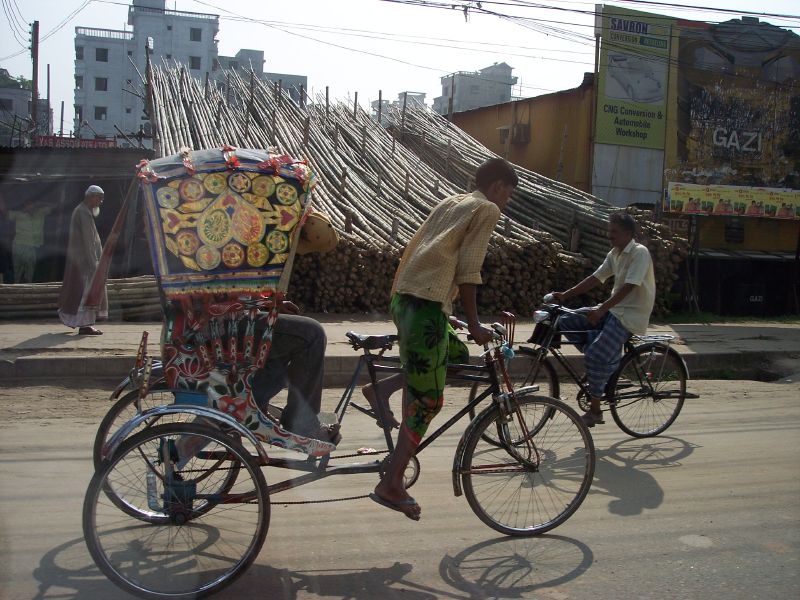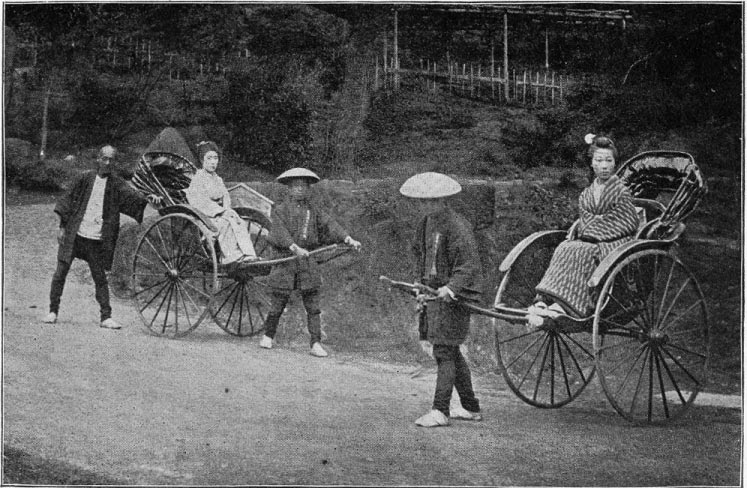|
Rickshaw Art
Rickshaw art or auto art is a form of neo-romanticism emerging in the Indian subcontinent specially in Bangladesh. The art in question consists of oil paintings on the rear of the canvas roof of rickshaws, done by local street artists, who also paint the various landscape, portraits and personal statements of the driver. History In Bangladesh, rickshaw art dates back to the 1950s and every conceivable part of the rickshaw is painted. In addition to geometric designs, there are depictions of flowers, birds and even popular actresses. The rickshaw can be decorated to show the driver's religious beliefs and sometimes even a commentary on current social issues. In Bangladesh, rickshaw art is looked down upon by the elite population. The three-wheeled pedicab, more commonly known as the rickshaw, has been around since the 1940s. Initially, they were undecorated, but starting in the late 1940s, the faces of movie stars began appearing as decorative motifs on shields at the back of the ... [...More Info...] [...Related Items...] OR: [Wikipedia] [Google] [Baidu] |
Ricksha 3
A rickshaw originally denoted a two- or three-wheeled passenger cart, now known as a pulled rickshaw, which is generally pulled by one person carrying one passenger. The first known use of the term was in 1879. Over time, cycle rickshaws (also known as pedicabs or trishaws), auto rickshaws, and electric rickshaws were invented, and have replaced the original pulled rickshaws, with a few exceptions for their use in tourism. Pulled rickshaws created a popular form of transportation, and a source of employment for male labourers, within Asian cities in the 19th century. Their appearance was related to newly acquired knowledge of ball-bearing systems. Their popularity declined as cars, trains and other forms of transportation became widely available. Auto rickshaws are becoming more popular in some cities in the 21st century as an alternative to taxis because of their low cost of hire. Etymology ''Rickshaw'' originates from the Japanese word ''jinrikisha'' (, ''jin'' = human, ... [...More Info...] [...Related Items...] OR: [Wikipedia] [Google] [Baidu] |
Truck Art In South Asia
Truck art in South Asia is a popular form of regional decoration, with trucks featuring elaborate floral patterns and calligraphy. It is especially common in Pakistan and India. During the War in Afghanistan, Pakistani decorated trucks that ran services between Pakistan and Afghanistan came to be known as jingle trucks by American troops and contractors who were deployed across the latter. "Jingle truck" origin The term "jingle truck" is military slang that was coined by American troops serving in Afghanistan, although it may also date back to the British colonial period. The term came to be because of the jingling sound that the trucks make due to the chains and pendants hanging from the bumpers of the vehicles. Practice Many trucks and buses are highly customized and decorated by their owners. External truck decoration can cost thousands of dollars. The decoration often contains elements that remind the truck drivers of home, since they may be away from home for months at a ... [...More Info...] [...Related Items...] OR: [Wikipedia] [Google] [Baidu] |
Decorated Vehicles
In addition to its ordinary English meaning, decorated can mean: *In architecture, "Decorated", "Decorated Period English Gothic is an architectural style that flourished from the late 12th until the mid-17th century. The style was most prominently used in the construction of cathedrals and churches. Gothic architecture's defining features are pointed ar ...", or "Decorated Gothic" is a period and style of mediaeval Gothic architecture. * A person who has been awarded a military award or decoration is often said to have been "decorated". See also * Decoration (other) {{disambig ... [...More Info...] [...Related Items...] OR: [Wikipedia] [Google] [Baidu] |
Bangladeshi Painting
Bangladeshis ( bn, বাংলাদেশী ) are the citizens of Bangladesh, a South Asian country centered on the transnational historical region of Bengal along the eponymous bay. Bangladeshi citizenship was formed in 1971, when the permanent residents of the former East Pakistan were transformed into citizens of a new republic. Bangladesh is the world's eighth most populous nation. The vast majority of Bangladeshis are ethnolingustically Bengalis, an Indo-Aryan people. The population of Bangladesh is concentrated in the fertile Bengal delta, which has been the center of urban and agrarian civilizations for millennia. The country's highlands, including the Chittagong Hill Tracts and parts of the Sylhet Division, are home to various tribal minorities. Bengali Muslims are the predominant ethnoreligious group of Bangladesh with a population of 150.36 million, which makes up 91.04% of the country's population as of 2022. The minority Bengali Hindu population made up appr ... [...More Info...] [...Related Items...] OR: [Wikipedia] [Google] [Baidu] |
Arts In Pakistan
The arts are a very wide range of human practices of creative expression, storytelling and cultural participation. They encompass multiple diverse and plural modes of thinking, doing and being, in an extremely broad range of media. Both highly dynamic and a characteristically constant feature of human life, they have developed into innovative, stylized and sometimes intricate forms. This is often achieved through sustained and deliberate study, training and/or theorizing within a particular tradition, across generations and even between civilizations. The arts are a vehicle through which human beings cultivate distinct social, cultural and individual identities, while transmitting values, impressions, judgments, ideas, visions, spiritual meanings, patterns of life and experiences across time and space. Prominent examples of the arts include: * visual arts (including architecture, ceramics, drawing, filmmaking, painting, photography, and sculpting), * literary arts (includin ... [...More Info...] [...Related Items...] OR: [Wikipedia] [Google] [Baidu] |
Arts In Bangladesh
The arts are a very wide range of human practices of creative expression, storytelling and cultural participation. They encompass multiple diverse and plural modes of thinking, doing and being, in an extremely broad range of media. Both highly dynamic and a characteristically constant feature of human life, they have developed into innovative, stylized and sometimes intricate forms. This is often achieved through sustained and deliberate study, training and/or theorizing within a particular tradition, across generations and even between civilizations. The arts are a vehicle through which human beings cultivate distinct social, cultural and individual identities, while transmitting values, impressions, judgments, ideas, visions, spiritual meanings, patterns of life and experiences across time and space. Prominent examples of the arts include: * visual arts (including architecture, ceramics, drawing, filmmaking, painting, photography, and sculpting), * literary arts (includin ... [...More Info...] [...Related Items...] OR: [Wikipedia] [Google] [Baidu] |
Arts In India
The arts are a very wide range of human practices of creative expression, storytelling and cultural participation. They encompass multiple diverse and plural modes of thinking, doing and being, in an extremely broad range of media. Both highly dynamic and a characteristically constant feature of human life, they have developed into innovative, stylized and sometimes intricate forms. This is often achieved through sustained and deliberate study, training and/or theorizing within a particular tradition, across generations and even between civilizations. The arts are a vehicle through which human beings cultivate distinct social, cultural and individual identities, while transmitting values, impressions, judgments, ideas, visions, spiritual meanings, patterns of life and experiences across time and space. Prominent examples of the arts include: * visual arts (including architecture, ceramics, drawing, filmmaking, painting, photography, and sculpting), * literary arts (includin ... [...More Info...] [...Related Items...] OR: [Wikipedia] [Google] [Baidu] |
Indian Painting
Indian painting has a very long tradition and history in Indian art, though because of the climatic conditions very few early examples survive.Blurton, 193 The earliest Indian paintings were the rock paintings of prehistoric times, such as the petroglyphs found in places like Bhimbetka rock shelters. Some of the Stone Age rock paintings found among the Bhimbetka rock shelters are approximately 10,000 years old. India's ancient Hindu and Buddhist literature has many mentions of palaces and other buildings decorated with paintings ('' chitra''), but the paintings of the Ajanta Caves are the most significant of the few ones which survive. Smaller scale painting in manuscripts was probably also practised in this period, though the earliest survivals are from the medieval period. A new style emerged in the Mughal era as a fusion of the Persian miniature with older Indian traditions, and from the 17th century its style was diffused across Indian princely courts of all religions, each ... [...More Info...] [...Related Items...] OR: [Wikipedia] [Google] [Baidu] |
Visual Arts Media
The visual system comprises the sensory organ (the eye) and parts of the central nervous system (the retina containing photoreceptor cells, the optic nerve, the optic tract and the visual cortex) which gives organisms the sense of sight (the ability to detect and process visible light) as well as enabling the formation of several non-image photo response functions. It detects and interprets information from the optical spectrum perceptible to that species to "build a representation" of the surrounding environment. The visual system carries out a number of complex tasks, including the reception of light and the formation of monocular neural representations, colour vision, the neural mechanisms underlying stereopsis and assessment of distances to and between objects, the identification of a particular object of interest, motion perception, the analysis and integration of visual information, pattern recognition, accurate motor coordination under visual guidance, and more. The ... [...More Info...] [...Related Items...] OR: [Wikipedia] [Google] [Baidu] |
Rickshaw
A rickshaw originally denoted a two- or three-wheeled passenger cart, now known as a pulled rickshaw, which is generally pulled by one person carrying one passenger. The first known use of the term was in 1879. Over time, cycle rickshaws (also known as pedicabs or trishaws), auto rickshaws, and electric rickshaws were invented, and have replaced the original pulled rickshaws, with a few exceptions for their use in tourism. Pulled rickshaws created a popular form of transportation, and a source of employment for male labourers, within Asian cities in the 19th century. Their appearance was related to newly acquired knowledge of ball-bearing systems. Their popularity declined as cars, trains and other forms of transportation became widely available. Auto rickshaws are becoming more popular in some cities in the 21st century as an alternative to taxis because of their low cost of hire. Etymology ''Rickshaw'' originates from the Japanese word ''jinrikisha'' (, ''jin'' = human, ... [...More Info...] [...Related Items...] OR: [Wikipedia] [Google] [Baidu] |







